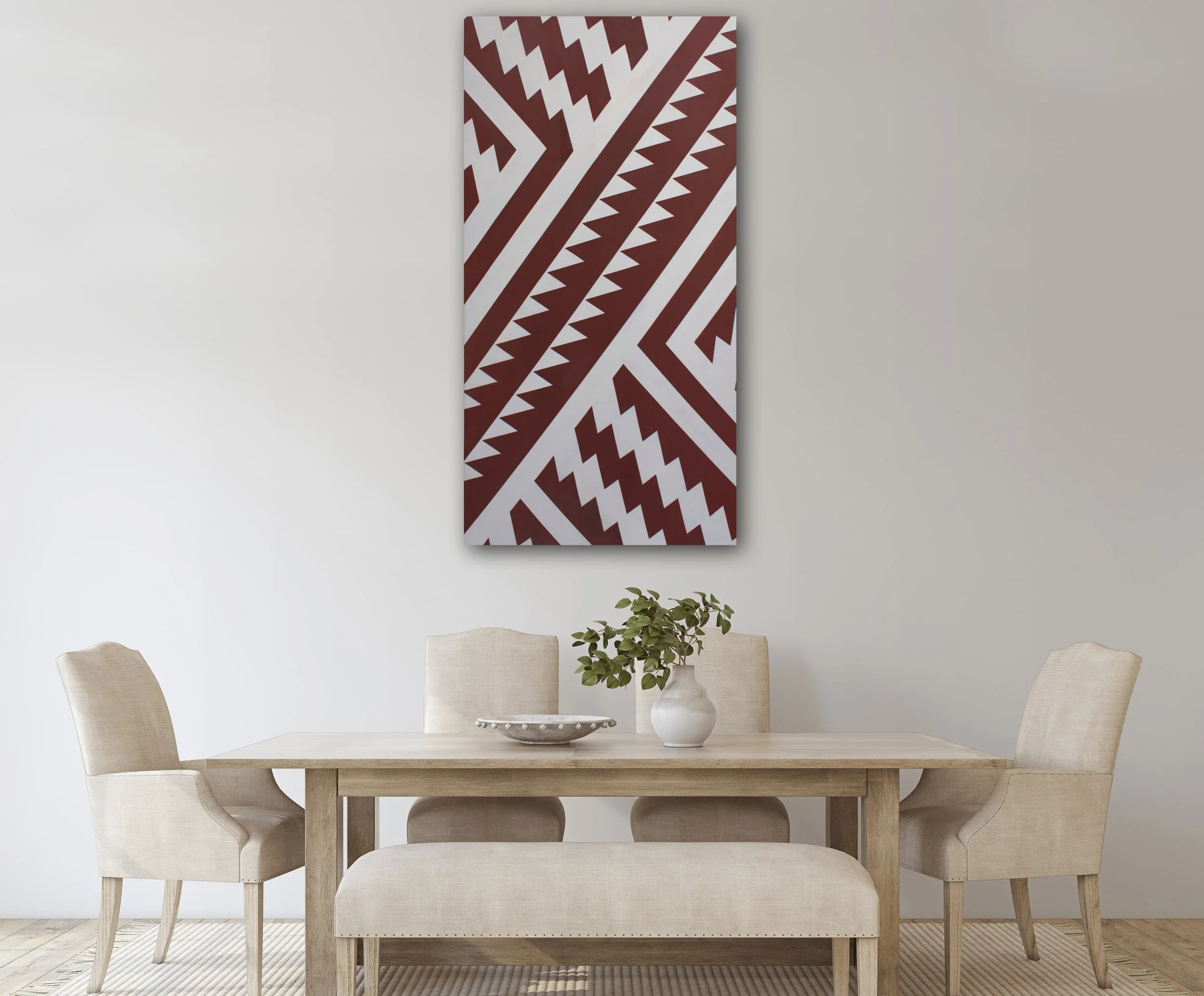
InBetween Lands:
Jacob T. Frye & David Naranjo
Part of my work in this exhibit features a polyptych piece consisting of 4 panel pieces aimed to address my own cultural background of what it means to not just be of the Tewa and Keres people but Spanish as well. Instead of focusing on the clash of culture dynamics, I choose to harness and focus on the unique complex nature of my own cultural heritage in order to bring to light the beauty I see within my familial legacy. All in all, I don’t see my paintings as “art” but rather visual prayers and my personal way of connecting to the divine.
Pueblo people see the world through many perspectives and interpret it through our work. Tony Chaverria best explains this concept, “The painter, the potter and makers; decorations aren’t just for artistic flourish but echoes their home, their place in the universe. It’s in this space where the SEEN and UNSEEN exists TOGETHER,”(podcast, 2022) I am utilizing and incorporating cultural imagery and symbolism in my work not just for ornate and decorative purposes but rather to carry deep symbolic
Jacob Thomas Frye was born in Santa Fe, New Mexico and is a member of Tesuque Pueblo. He is a fourth-generation potter and painter. Frye comes from a diverse ethnic background that is true New Mexican. Frye’s mother is a traditional potter from Tesuque Pueblo, and his father is an artist from Ft. Collins, Colorado. Frye's passion for art and learning started when he was five years old, working alongside his parents with clay among other art forms. During his childhood education, he received first place in pottery at the Old School Gallery at El Morro Area Arts Council. In the fall of 2019 Frye received his Bachelor of Fine Arts from the Institute of American Indian Arts. Frye would like to continue his education with the Institute of American Indian Arts, by enrolling into the master’s program. Frye is inspired by great Renaissance Pueblo artists like artist Nampeyo from the Hopi Pueblo in north eastern Arizona, who gave life to Siyakki polychrome. In addition, his influences include Maria Martinez from San Idelfonso Pueblo who reestablished black on black pottery and his great grandfather Thomas Vigil “Pan Yo Pin,” form Tesuque pueblo who produced watercolor paintings in the 1900s.
significance within a traditional setting as well as, creating a visual dialogue with figure to ground relationships in order to create BALANCE.
For Tewa People, we perceive the spirit world to be a reflection of this world. As Rina Swentzell explains in the book Painted Reflections: isomeric design in ancestral pueblo pottery, “Pueblo people conceive reality as involving a spiritual world that is complementary and consubstantial with the physical world,” (Ortman and Traugott, 65). Our belief systems and cultural constructs are built upon this DUAL PERCEPTION or a MIRROR IMAGE/REFLECTION of that with the spiritual and the physical. As Ortman and Traugott explain from the book painted Reflections:
“Pueblo people use this phenomenon of mirror-image reflection to conceptualize the relationship between the spirit world and the physical world. In this construal reality, the spirit world is a mirror image of the physical world, and one can contact this world at any number of places where water stands still-whether this is the form of clouds and snow on mountains and hills, pools of water at mountain lakes, marshes or springs, moist caves, or even subterranean kivas. As water circulates through the physical so does animacy flow through both worlds. This idea today is expressed today in a variety of ritual practices. For example, when pueblo men prepare for ceremonies they often cover their hands with wet white clay so they can “lay the fog,” making contact with the spirit world through their actions. This idea seems to be that the point of contact between the physical and the spirit world is a wet surface, of a lake or of wet hands” (Ortman, Traugott 66).
My way of expressing this dual perception in these paintings is by literally portraying it in my art. If you look at a painting and split it equally vertically or horizontally, it is is a mirror image or reflection of one another while keeping figure to ground relationships in mind - which is also dual concept in art. I added symbols and iconography specific to clouds/moisture (to lay the fog) and birds/feathers(intermediaries between us and the heavens), as well as the catholic cross (Spanish faith) and combined them into one cohesive piece in order to create BALANCE. It is my way of creating the SEEN and UNSEEN, a MIRROR IMAGE/REFLECTION with that of the spiritual and the physical.
Since receiving his BFA, Frye has continued working on pottery. During 2021, Frye participated in the Museum of Indian Arts and Culture Virtual Series, demonstrating his techniques within his building process of pottery. Frye also had the opportunity to give a hands-on pottery demonstration for The Doel Reed Center in Taos, New Mexico. Frye was also featured in the Poeh Cultural Center’s Pottery Demonstration compilation videos sponsored by the Smithsonian’s National Museum. Most recently Frye participated in a pottery demonstration at the “Here Now and Always” event hosted by the Museum of Indian Arts Culture. Keeping busy he continues to create pottery, enhance his abilities, and learn new techniques.





















